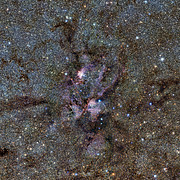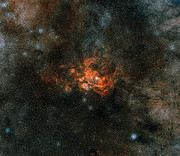Pressmeddelande
VISTA dammar av en kosmisk hummer
Ny bild i infrarött ljus av NGC 6357
20 februari 2013
En ny bild från ESO:s teleskop VISTA visar upp ett himmelskt landskap med lysande gasmoln och stoft som omger unga heta stjärnor. Den infraröda bilden visar upp stjärnbarnkammaren NGC 6357 i nytt ljus. Den togs som en del av VISTA:s kartläggning av hela Vintergatan som görs för att kartlägga galaxens struktur och förklara hur den bildades.
NGC 6357 ligger 8000 ljusår bort i stjärnbilden Skorpionen, och kallas ibland för Hummernebulosan [1], tack vare hur den ser ut i bilder tagna i synligt ljus. Det år ett område som är fullt av gigantiska gasmoln och stråk av mörkt stoft. I dessa moln bildas just nu stjärnor, bland annat massiva heta stjärnor som lyser starkt blå-vitt i infrarött ljus.
Den här bilden använder infraröda data från ESO:s teleskop VISTA (Visible and Infrared Survey Telescope for Astronomy) som finns på Paranalobservatoriet i Chile. Bilden är en mindre del av en stor karläggning som kallas VVV (VISTA Variables in the Vía Láctea) som kartlägger de centrala delarna av vår galax (eso1242). Den här nya bilden visar upp en drastiskt annorlunda vy än de tagna i synligt ljus - se till exempel bilden som är tagen med det danska 1,5-metersteleskopet vid La Silla - eftersom infraröd strålning tar sig igenom allt stoft som skymmer objektet [2].
En av de ljusstarka unga stjärnorna i NGC 6357 kallas Pismis 24-1. Den var under en tid den mest massiva stjärnan man hittills funnit - ända tills man insåg att den faktiskt bestod av åtminstone tre gigantiska starkt lysande stjärnor, var och en med en massa som var mindre än 100 gånger vår sols massa. Trots detta är dessa stjärnor ändå tungviktare - några av de mest massiva i vår galax. Pismis 24-1 är det ljusstarkaste objektet i stjärnhopen Pismis 24, en klunga stjärnor som alla tros ha bildats samtidigt som NGC 6357.
VISTA är världens största och mest kraftfulla kartläggningsteleskop och används för att kartlägga himlen i infrarött ljus. I kartläggningen VVV skannar man Vintergatans bula och en del av dess plan för att skapa en gigantiskt datamängd som kan hjälpa astronomerna att lära sig mer om vår galax ursprung, struktur och tidiga liv.
Delar av NGC 6357 har också observerats av NASA/ESA:s Hubbleteleskop (heic0619a) och ESO:s teleskop VLT (eso1226a). Båda teleskopen har tagit bilder i synligt ljus av olika delar av området - om man jämför dessa bilder med den nya infraröda bilden visar några slående skillnader. I infrarött ljus är de rödfärgade plymerna mycket mindre, med stråk av svag lilafärgad gas som sträcker sig ut från nebulosan i olika områden.
Noter
[1] Även området Messier 17, där stjärnor håller på att bildas (se eso0925), kallas ibland Hummernebulosan, fast går oftare under sitt vanligare namn, Omeganebulosan.
[2] Infraröda observationer kan avslöja saker som annars inte syns i bilder tagna i synligt ljus, till exempel om ett objekt är för kallt, dolt av tjocka lager stoft, eller är väldigt avlägset, vilket gör att ljuset från det sträcks ut mot rödare våglänger av universums utvidning.
Mer information
ESO, Europeiska sydobservatoriet, är Europas främsta samarbetsorgan för astronomisk forskning och världens mest produktiva astronomiska observatorium. Det stöds av 15 länder: Belgien, Brasilien, Danmark, Finland, Frankrike, Italien, Nederländerna, Portugal, Schweiz, Spanien, Storbritannien, Sverige, Tjeckien, Tyskland och Österrike. ESO:s ambitiösa verksamhet rör design, konstruktion och drift av avancerade markbaserade forskningsanläggningar som gör det möjligt för astronomer att göra banbrytande vetenskapliga upptäckter. ESO spelar dessutom en ledande roll i att främja och organisera samarbeten inom astronomisk forskning. ESO driver tre unika observationsplatser i Chile: La Silla, Paranal och Chajnantor. Vid Paranal finns Very Large Telescope, världens mest avancerade observatorium för synligt ljus, och två kartläggningsteleskop: VISTA, som observerar infrarött ljus och är världens största kartläggningsteleskop, samt VST, det största teleskopet som konstruerats för att kartlägga himlavalvet i synligt ljus. ESO bidrar dessutom till ALMA, ett revolutionerande astronomiskt teleskop och världens hittills största astronomiska projekt. ESO planerar för närvarande bygget av det europeiska extremt stora 39 metersteleskopet för synligt och infrarött ljus, E-ELT. Det kommer att bli ”världens största öga mot himlen”.
Länkar
Kontakter
Richard Hook
ESO, La Silla, Paranal, E-ELT & Survey Telescopes Press Officer
Garching bei München, Germany
Tel: +49 89 3200 6655
Mobil: +49 151 1537 3591
E-post: rhook@eso.org
Johan Warell (press contact Sverige)
ESO Science Outreach Network
Skurup, Sverige
Tel: +46-706-494731
Email: eson-sweden@eso.org
Om pressmeddelandet
| Pressmeddelande nr: | eso1309sv |
| Namn: | NGC 6357 |
| Typ: | Milky Way : Nebula : Type : Star Formation |
| Facility: | Visible and Infrared Survey Telescope for Astronomy |
| Instruments: | VIRCAM |






